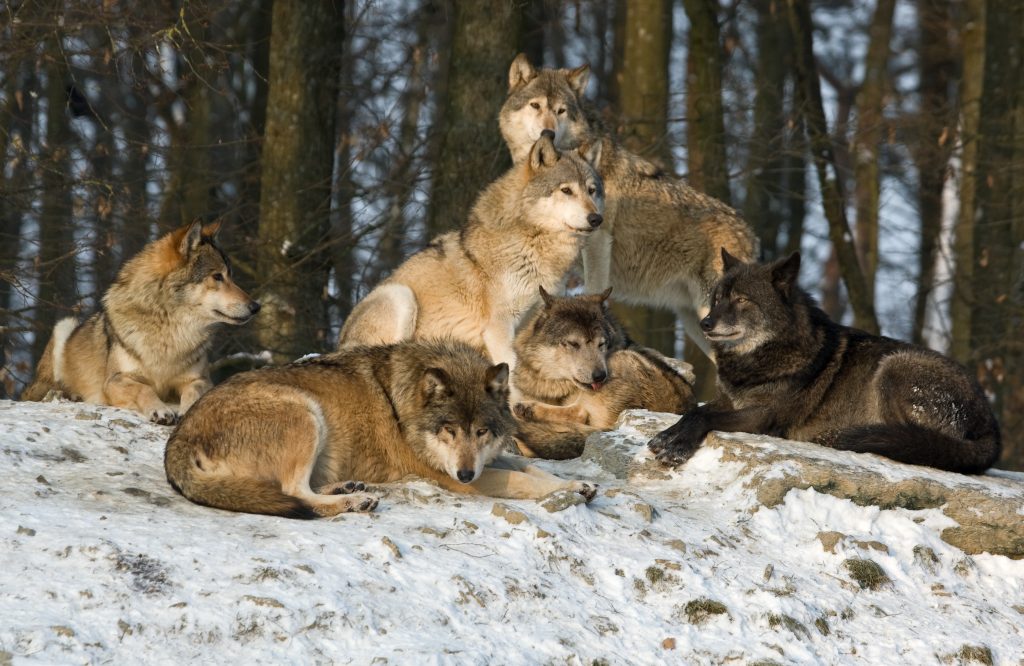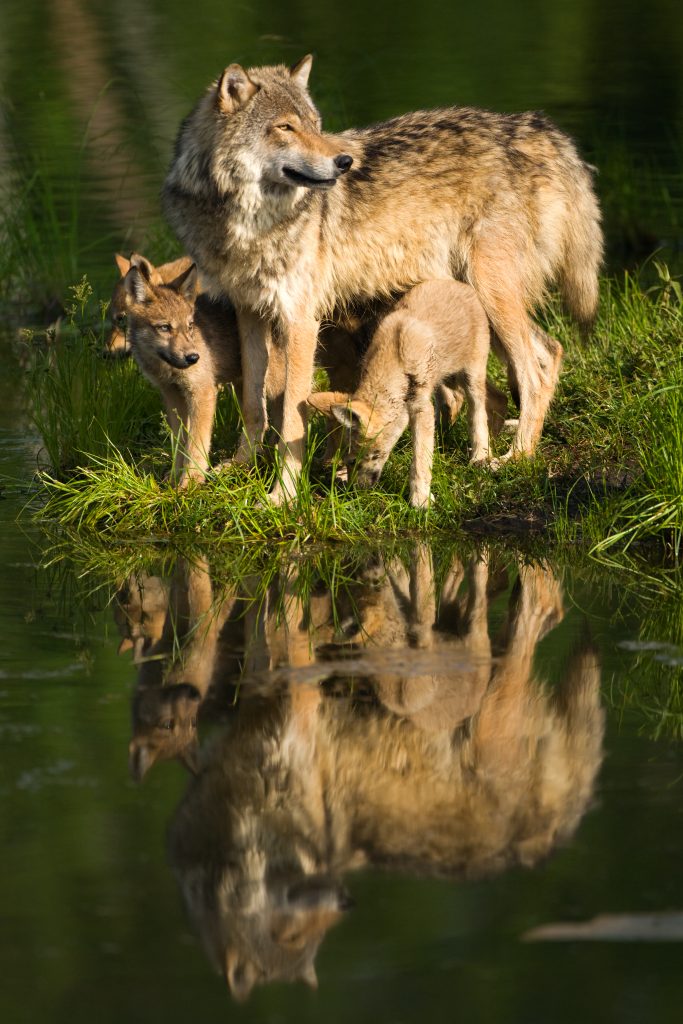by the Center for Human-Carnivore Coexistence (5/20)
Key Points…
- Taxonomy, the naming and grouping of living organisms, is complicated for wolves. Five subspecies of gray wolf (Canis lupus) are currently recognized in North America, including the Mexican wolf of the southwestern U.S. The red wolf (Canis rufus) of the southeastern U.S. is considered a distinct species.
- Gray wolves, the largest wild canine, are social animals that can live in a variety of habitat types, wherever there is enough prey and where they are tolerated by humans.
- Gray wolves have been eliminated from much of their former range. Today, about 300,000 wolves occur globally, including 60,000 in Canada, 7700-11,200 in Alaska, and about 6000 in the lower 48 U.S. states.
Taxonomy of gray wolves
Taxonomy refers to the hierarchical naming and grouping of living organisms based on their physical and genetic characteristics. Taxonomy is a system invented by people and can be confusing. Most species can be distinguished by their physical appearance. Other species can look very similar and be genetically different. Some species can look different but still breed with each other. The taxonomy of gray wolves (Canis lupus) is complicated and the subject of ongoing debate among scientists.1-5 Since 1993, five subspecies have been recognized in North America.6

Subspecies are the taxonomic rank below species. Typically, a subspecies lives in a separate area than the rest of the species and has different physical or genetic traits. Subspecies have a third part added to their scientific name. For instance, the Mexican gray wolf (Canis lupus baileyi), which lives in the southwest United States, is the rarest subspecies of gray wolf.7
The number and geographic boundaries of gray wolf subspecies in North America have not been fully resolved. For example, some scientists consider wolves in parts of the eastern Great Lakes into Canada as a distinct species – the eastern wolf (Canis lycaon).8-9 Others think these wolves are not a distinct species but rather hybrids between gray wolves and coyotes.10
The red wolf (Canis rufus) lives in the southeastern United States.11 Genetic evidence suggests red wolves are more closely related to coyotes than gray wolves.3 But, red wolves living in the wild today are considered distinct from both coyotes and gray wolves (notice the different species name – rufus versus lupus). Current evidence supports red wolves as a distinct species.
Biology of Gray Wolves

Gray wolves are the largest wild members of Canidae, the dog family.12-14 Coyotes, foxes, and domestic dogs are other species in that family. Female wolves typically weigh 60 to 100 pounds, and males 70 to 115 pounds. Wolves are social and live in groups called packs, which typically include a breeding pair, their offspring, and other adults that may or may not be breeders. In the Rocky Mountains, packs average about 10 wolves in areas with little human impact, such as National Parks. Outside of parks, pack size is often less due to legal hunting, poaching, and livestock control. Wolf packs live within territories, which they defend from other wolves. Territory sizes range from 50 to over 1,000 square miles, depending on factors such as prey availability and human presence on the landscape.

Wolves sexually mature at age two and can reproduce most of their lives. Under natural conditions, average wolf lifespan is about 5-6 years. In human-dominated landscapes, lifespan is less, with most mortality due to humans.15 Wolves can live up to 14 years, although this is rare.
Wolves typically mate in January through March and sometimes mate for life. After a gestation period of about two months, four to six pups are born in early spring and are cared for by the entire pack. By seven to eight months, pups are almost fully grown and begin traveling with adults. A maturing wolf may stay with the pack and attempt to gain a breeding position. More often, it may leave to try to find a mate and start a new pack.
Gray wolves use many different habitat types, from Arctic tundra to forests, grasslands, and deserts wherever there is enough prey and where they are tolerated by humans. In the western United States, the best habitat for wolves is on public lands where both these needs are met. In the Rocky Mountains, wolves feed on a variety of prey, primarily elk, but also deer and occasionally moose. In Yellowstone National Park, elk make up about 90% of their diet. Wolves also eat small mammals, insects, and berries.
How many wolves live in the wild?
Historically, the gray wolf was the most widely distributed land mammal on earth, other than humans.16,17 They lived through most of the Northern Hemisphere. Due to habitat loss and predator control programs, wolves were eliminated through much of their former range. Today, they inhabit parts of North America, Europe, and Asia. About 300,000 wolves occur globally.16
In North America, gray wolves once ranged from Alaska and Canada to Mexico, occupying most of North America. Wolves were eliminated from the lower 48 U.S. states, except in northeastern Minnesota and Isle Royale National Park, Michigan.17 Wolves have since recovered in some areas. Today, they occupy only 15% of their historic range in the lower 48 states.18
Currently, over 60,000 gray wolves live in Canada and 7700-11,200 live in Alaska.19 About 6000 inhabit the lower 48 states. This includes about 4000 wolves in the western Great Lakes states of Michigan, Minnesota, and Wisconsin. About 2,000 wolves live in the northern Rocky Mountain states of Idaho, Montana, and Wyoming. Smaller numbers of wolves live in the Pacific Northwest, including Washington, Oregon, and Northern California.20 A group of up to 6 wolves was confirmed in northwest Colorado in 2020, and an additional lone wolf was confirmed in north-central Colorado near Walden in summer 2019.21-22
The Mexican gray wolf was reintroduced to Arizona, New Mexico, and northern Mexico starting in the late 1990’s. At least 160 Mexican gray wolves now live in the wild in the U.S.7 A small and unknown number of Mexican wolves are free-ranging in northern Mexico.
The red wolf is one of the world’s most endangered large carnivores, listed as Critically Endangered by the International Union for the Conservation of Nature (IUCN).23-24 Red wolves were reintroduced into eastern North Carolina starting in the late 1980’s.11 Currently, about 40 red wolves live in the wild.
References
- Chambers, S.M., Fain, S.R., Fazio, B. and Amaral, M., 2012. An account of the taxonomy of North American wolves from morphological and genetic analyses. North American Fauna, 77(1), pp.1-67.
- National Center for Ecological Analysis and Synthesis. 2014. Review of proposed rule regarding status of the wolf under the Endangered Species Act. NCEAS. Santa Barbara, CA.
- National Academies of Sciences, Engineering, and Medicine. 2019. Evaluating the Taxonomic Status of the Mexican Gray Wolf and the Red Wolf. Washington, DC: The National Academies Press.
- U.S. Fish and Wildlife Service. 2019. Endangered and Threatened Wildlife and Plants; Removing the Gray Wolf (Canis lupus) from the List of Endangered and Threatened Wildlife.
- Atkins. 2019. Summary Report of Independent Peer Reviews for the U.S. Fish and Wildlife Service Gray Wolf Delisting Review.
- Nowak, R.M., 1995. Another look at wolf taxonomy. In Carbyn, L. N., Fritts, S. H., and Seip, D. R. Eds. Ecology and conservation of wolves in a changing world (Vol. 35, pp. 375-398). Canadian Circumpolar Institute, Edmonton, Canada.
- U.S. Fish and Wildlife Service. 2020. Mexican Wolf.
- Heppenheimer, E., Harrigan, R.J., Rutledge, L.Y., Koepfli, K.P., DeCandia, A.L., Brzeski, K.E., Benson, J.F., Wheeldon, T., Patterson, B.R., Kays, R. and Hohenlohe, P.A., 2018. Population genomic analysis of North American eastern wolves (Canis lycaon) supports their conservation priority status. Genes, 9:606.
- Hohenlohe, P.A., Rutledge, L.Y., Waits, L.P., Andrews, K.R., Adams, J.R., Hinton, J.W., Nowak, R.M., Patterson, B.R., Wydeven, A.P., Wilson, P.A. and White, B.N., 2017. Comment on “Whole-genome sequence analysis shows two endemic species of North American wolf are admixtures of the coyote and gray wolf”. Science Advances, 3(6), p.e1602250.
- vonHoldt, B.M., Cahill, J.A., Fan, Z., Gronau, I., Robinson, J., Pollinger, J.P., Shapiro, B., Wall, J. and Wayne, R.K., 2016. Whole-genome sequence analysis shows that two endemic species of North American wolf are admixtures of the coyote and gray wolf. Science Advances, 2(7), p.e1501714.
- U.S. Fish & Wildlife Service. 2020. Red Wolf (Canis rufus).
- U.S. Fish & Wildlife Service. 2006. Gray Wolf Biology Questions and Answers.
- U.S. Fish & Wildlife Service. 2007. Gray wolf (Canis lupus).
- National Park Service. 2020. Gray Wolf.
- Smith, D.W., Bangs, E.E., Oakleaf, J.K., Mack, C., Fontaine, J., Boyd, D., Jimenez, M., Pletscher, D.H., Niemeyer, C.C., Meier, T.J. and Stahler, D.R., 2010. Survival of colonizing wolves in the northern Rocky Mountains of the United States, 1982–2004. The Journal of Wildlife Management, 74(4), pp.620-634.
- Mech, L. David; Boitani, Luigi, eds. (2003). Wolves: Behavior, Ecology and Conservation. University of Chicago Press. p. 230. ISBN 978-0-226-51696-7.
- Mech, L.D., 2017. Where can wolves live and how can we live with them?. Biological Conservation, 210, pp.310-317.
- Bruskotter, J.T., Vucetich, J.A., Enzler, S., Treves, A. and Nelson, M.P., 2014. Removing protections for wolves and the future of the US Endangered Species Act (1973). Conservation Letters, 7(4), pp.401-407.
- U.S. Fish & Wildlife Service. 2020. Gray Wolf. Current Population in the United States.
- California Department of Fish and Wildlife. 2020. Gray Wolf.
- Colorado Parks and Wildlife. 2020. February 13 2020 Colorado Parks and Wildlife News Release: Genetic tests confirm presence of wolves in Colorado.
- Colorado Parks and Wildlife. 2020. Wolf Management.
- Phillips, M. (2018). Canis rufus (errata version published in 2020). The IUCN Red List of Threatened Species 2018. e.T3747A163509841.
- Ripple, W.J., Estes, J.A., Beschta, R.L., Wilmers, C.C., Ritchie, E.G., Hebblewhite, M., Berger, J., Elmhagen, B., Letnic, M., Nelson, M.P. and Schmitz, O.J., 2014. Status and ecological effects of the world’s largest carnivores. Science, 343(6167), p.1241484.





